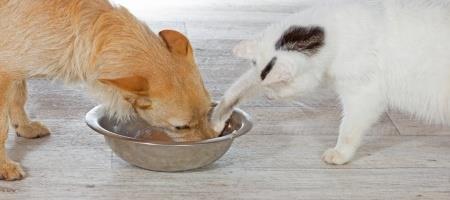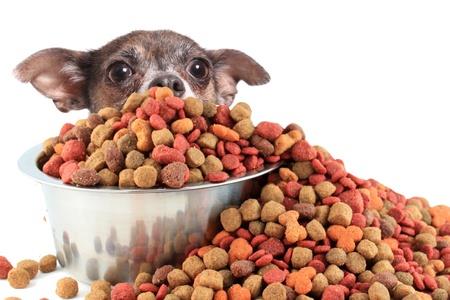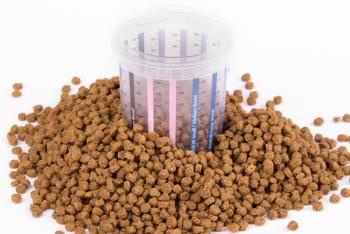Is your cat snatching kibbles out of your dog’s food bowl? You are not alone. Stealing is a common behavior problem reported by cat owners, and, if your dog happens to be a lazy “I don’t give a bark” guard, then nothing is there to stop your cat from grabbing some extra bites at the expense of your pooch.

Or is there? In this article, you will learn how to stop your cat from stealing food right out of your dog’s bowl and why you should care.
Is it bad that your cat steals dog food?
Why should you care? The cat takes an extra bite; besides the dog getting less, which is clearly his own fault, so what? Well, there are some problems associated with this behavior:
- Obesity is a major concern with indoor cats in the twenty-first century, and there are only two cures—tons of exercise and controlled food intake. To achieve the latter, you must prevent your cat feasting from your dog’s bowl. If your cat is out of shape, learn more about obesity prevention in cats here.
- Different nutritional needs of dogs and cats is the second problem. While not completely off, dog food isn’t appropriate for cats (or cat food for dogs) in the long run. Different needs in terms of protein/fat/carbohydrate ratio and in minerals and vitamins mean that your dog’s balanced food is balanced for dogs only. Of course, nothing bad happens if your cat grabs a bite now and then, but if it occurs regularly, it may unbalance your cat’s otherwise balanced diet.
- Dog feels stressed. Don’t you feel sad for the dog? Most won’t care about the dog’s ego suffering from not being able to protect his own food, but a can sneaking around can make the dog a voracious eater or even aggressive towards the cat.
How do you stop a cat from stealing dog food?
Regardless of whether you or your dog think that your cat’s kleptomania is distasteful, you can see that there are good reasons to stop it. Luckily, the solution is simple.
Stop free-feeding your dog!

You don’t need to reinvent the wheel or invent a bicycle. If there is no free dog food on the ground, the cat won’t steal it; one cannot steal what isn’t there.
There is not a single cat deterrent (and we have tried many of them) that can both keep the cat away and let the dog in. There are cat doors that are opened/locked by the presence of a pet’s microchip, but they solve the problem for smaller dogs only and won’t prevent an intelligent cat from entering together with the dog.
A cheaper solution would be to put your dog on scheduled meals and feed your cat at the same time in a separate area. Alternatively, you can play with your cat or close the door to keep him out while the dog eats.
Are you scared of scheduled meals? Don’t be, most dogs are completely capable of going with two meals per day—let’s say, one in the morning and one in the afternoon when you are most likely to be home. The meals don’t even need to be aligned with the clock. If you come home at different times each day, so be it; your dog will associate mealtime not with 6 pm, but with your arrival.
To nudge you even further, here are several benefits from scheduled feeding:
- The most obvious one is obesity prevention. According to the American Veterinary Medical Association, more than half of dogs in the U.S. are overweight or obese, which is a direct consequence of eating too much and moving too little. Dog owners have 100% control over both.
- Feeding dogs on a schedule also turns food into a training tool. Your dog will be more motivated by treats if there is no free food just lying around.
- Not having food on the ground at all times keeps away other intruders besides cats. For example, mice, rats, raccoons and other pests are often reported to steal dog food. The solution to this is either to feed your dog inside or feed him on a schedule.
How to put your dog on a feeding regime

To put your dog on a feeding schedule, measure the amount of food your dog needs per day. You will find this information on the package of any commercial dog food. Split the amount into two or more parts. Each part will be one meal for your dog.
Feel free to schedule meals at times convenient for you, spreading them evenly throughout the 24-hour period.
Take your dog’s current food bowl away at least a few hours before the first meal, so he receives the meal on an empty stomach. Since your dog is used to food always being there and not running away, he may not even wink an eye for his meal. Don’t worry if that happens.
Remove anything that is left after 15 to 30 minutes. Serve a single portion when the next mealtime comes (do not compensate for what your dog did not eat in the previous meal) and, again, remove everything after some time has passed.
Soon you will realize that there are no leftovers to pick up, and nothing for your cat to steal, either.
